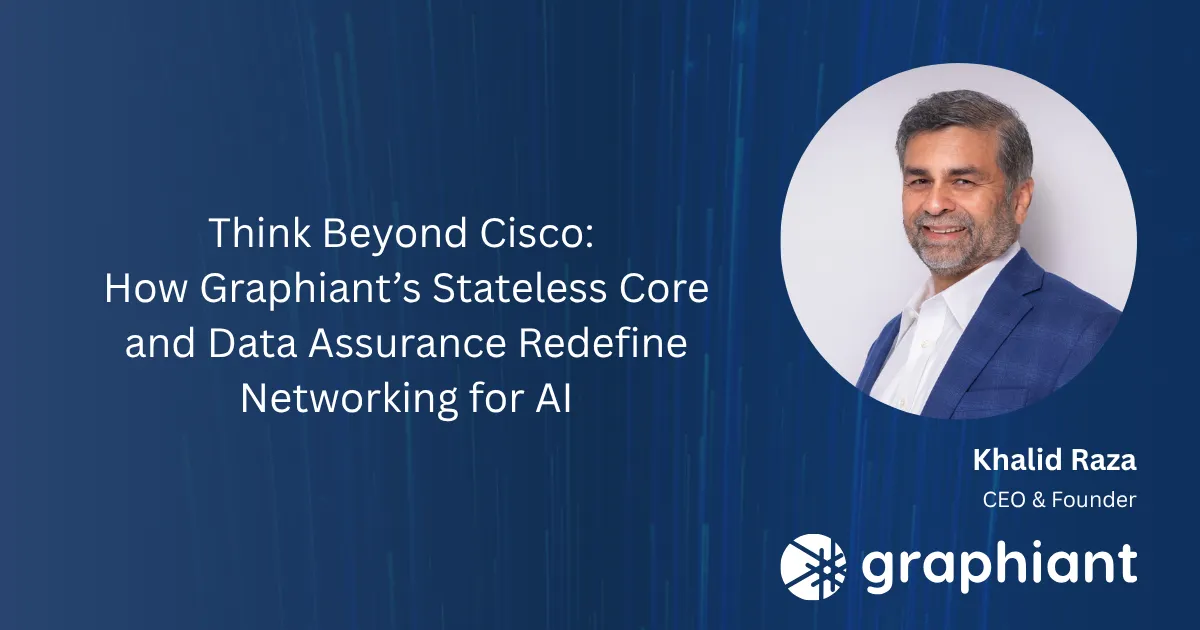Think Beyond Cisco: How Graphiant’s Stateless Core and Data Assurance Redefine Networking for AI


As enterprises rush to adopt AI, most are being told the same thing: fix your data. Clean it. Structure it. Secure it. But beneath the surface of every AI success story is a hidden, often overlooked pillar — network infrastructure.
At Cisco Live, Anurag Dhingra, SVP of Cisco’s Enterprise Connectivity Group, acknowledged what many already suspect: AI agents will soon flood enterprise environments, demanding ultra-low latency, scalability, and ubiquitous access. Yet Cisco’s answer to this future? Bigger boxes. Faster hardware. More ports.
This is not innovation — it’s acceleration of an old paradigm.
Cisco’s latest hardware release — a whole new set of boxes with numbers 8100-8500 routers — follows a familiar formula: respond to exponential traffic by building incrementally faster hardware. But the emerging world of agentic AI, edge intelligence, and distributed compute doesn’t just need a slightly faster speed.
Unlike conventional enterprise connectivity — typically designed around fixed, site-to-site topologies — Agentic AI introduces autonomous agents that interact dynamically and securely across multiple enterprises, partners, AI factories, and clouds. These real-time B2B use cases demand a new kind of network fabric.
Consider a fraud detection agent at a bank that needs to securely query transaction data from a payment processor. Or a supply chain optimization agent that must pull live inventory updates from a vendor’s ERP system. These interactions require secure, on-demand data exchange between AI agents in one enterprise and retrieval-augmented generation (RAG) systems in another.
Traditional models weren’t built for this. Both IPsec and MPLS VPNs rely on static, pre-configured, point-to-point tunnels like IPsec and SD-WAN — making them ill-suited for ephemeral, high-scale, dynamic workloads. To support each new agent-to-agent interaction, a new tunnel has to be manually created, neither scalable nor cost-effective.
Large meshes are not only expensive to deploy but also operationally complex to monitor, manage, and troubleshoot. The rise of agentic AI calls for a new, intelligent, policy-driven connectivity layer — one that can handle real-time, autonomous interactions with simplicity, agility, and built-in security.
At Graphiant, we’ve rejected the stateful model altogether in transit. Our stateless core reimagines how traffic is handled in modern enterprise. Rather than maintaining session state or being bound by centralized control planes, Graphiant uses cryptographic assurance and edge policy enforcement to route data dynamically across a globally distributed fabric.
What this means in practice:
Unlike traditional vendors, Graphiant isn’t building boxes — we’re building intent, identity, and trust.
In an AI-enabled enterprise, data is no longer just traffic — it’s a protected asset. Graphiant is the only platform that embeds Data Assurance natively into the network:
This isn’t a bolt-on feature or afterthought — it’s core to the Graphiant fabric.
In a world where rogue agents and generative systems may exploit internal data paths, Data Assurance is not optional — it’s foundational.
Cisco’s leadership acknowledges the coming AI storm. But their solution is to throw more hardware at the problem — faster switches, bigger routers, more bandwidth. That’s not what enterprise networks need.
What’s needed is a complete re-architecture of enterprise connectivity — one that treats data as the asset, policy as the perimeter, and sovereignty as non-negotiable.
Graphiant is the only platform delivering a true data infrastructure layer for modern enterprise connectivity:
The AI revolution won’t be won by faster hardware. It will be won by smarter infrastructure. Enterprises don’t need more routers. They need networks that think, adapt, and protect.
Cisco is building more hardware. Graphiant is building the future.
Resources